
My step-dad, who’s been in my life for over 25 years, is a
former lumberjack who currently operates a small two-person
mill on Vancouver Island. I'm a tree hugging nature punk. We
don’t always see eye to eye about political matters, but we
get along really well. We’ve done taxidermy projects together,
both love 35mm photography and he taught me how to drive on
logging roads when I was 16, making me back up for many
kilometers on an old stick-shift pick up truck. I decided to
sit down with him over the course of several evenings and
learn more about his experiences working in forestry.
How long have you worked in the logging industry?
Since I was 14. Since 1968.
In Creston? In the Kootenays?
Yep.
What were the first jobs you had?
Running a skidder and a cat and working in portable tie
mills.
What’s a skidder?
When a tree-faller falls a tree, it’s a 4-wheeled machine
that has a winch and choker so you hook on to the trees so you
can drag them to a landing so they can be loaded and hauled
out.
And what’s a portable tie mill?
It was a mill that could be towed behind a vehicle into the
bush and you pulled your logs to the mill. From there we
hauled the finished ties up to the CPR.
So you would mill it on site?
Ya you just bring the log onto the mill and cut it to the
size of a #1 or #2 railroad line. Then haul it to a CPR siding
and then they loaded it on to the rail cars and then it headed
to Calgary to be treated.
How long did you do that for?
We sold our tie mill in 1980. My cousin and I bought our own
when I was 23. We were young and dumb.
That’s a lot of responsibility at a young age. Were you
driving muscle cars or motor bikes?
Motor bikes. Because we spent so much time in the bush we all
had pick-ups.
What do you think about how things have been done thus far
in your experience during your lifetime in the forest industry?
Rape and pillage. They allowed way too much way too fast. In
the interior, Forestry is the one who spread the pine beetle,
in my opinion. 90% of what I did was salvaging jack pine
before it all split standing and couldn't be used after that.
One year after the tree dies it cracks and jack pine always
cracks in a spiral so you can’t use it for lumber.
So it all had to get logged?
Ya you had to salvage as much as you could before it got to
that point and became a fire hazard.
You mean that Forestry spread it or it was a result of
forestry practices?
Because the Forestry knew when the pine beetle hatched and
flew out of the trees. They made small business stop hauling
logs during that fly period so they wouldn't spread the
beetle. But all the big companies could haul all year long, it
didn’t matter. If you stood on a mountain and looked down into
the valley bottom that had a mild beetle infestation, the next
year you could see all the road systems 100 feet each side of
the roads all dead, and the next year the mountain was dead.
So like when did that all start?
In the 70’s. They knew then that the pine beetle flew and
that they were hatching out of logs as the logging trucks were
going down the road, then flying out and finding a new home.
Stopping the forest fires was the beginning of it. Forest
fires is mother natures way of rejuvenating, keeping disease
and insects under control.
What about the hemlock disease you see all over here?
It’s a spore and I don’t know anything about it, it attacks
the ends of branches. You can see it open up and all the
spores explode and spread.
So how long have you had the mill here?
2006
And it’s all second-growth you’re milling?
Yep. Aside from some dead-fall.
Where do you get your lumber from?
Woodlots, big companies, private landowners who are
developing business sites.
What are you milling and who are you selling to?
Locals and to building suppliers, building contractors,
renovation people.
What kind of products?
Custom cuts, so whatever custom people would like, decking
siding beams, fencing.
Do you think it’s possible to have a sustainable
second-growth mill?
Yes, but the problem is like Port Alberni right now just
opened up that brand new state-of-the-art mill and they can
grind up more wood in a day than has ever been done before.
Who’s running that?
San Group, it’s a big conglomeration. They bought Coulsons
out which was an old-growth mill. They bought that brand new
mill and they cant find enough wood to sustain themselves
right now. That's why they're on this side of the island
grabbing all of the wood that they can.
So there’s a lot of competition for wood right now?
Way more mills than there is wood. And the second-growth has
never been logged sustainably either. Nothing is done
sustainably unless it's done on an actual designated woodlot
then it has to be done sustainably, because that's the main
purpose of a woodlot. But crown land, they allocate the logs
to a mill and it’s Forestries job to make sure the mills are
sustained until the wood runs out, then everybody's out.
Where are we at right now?
Well wood's hard to find so that answers itself.
What do you think the solution is?
That's a hard thing to go because small mills employ way more
people than a large mill so you have a higher employment rate.
They consume far less volume of timber, because we’re not
modernized. But Forestry wanted to downsize and cut back so
the best way to do that was to eliminate most of the small
business and then they only have to take care of a couple of
big businesses.
When was that?
It started 30 or 40 years ago. My cousin is a millwright and
him and other millwrights, they built and designed a mill. It
consumes more wood in 8 hours than I can in 15 years. They
employ 26 men in the mill.
When people talk about all of the jobs that are tied to
forestry, are most of these jobs now with large corporations?
The thing is with the large corporations is they can afford
to pay a higher wage to the people they employ because the
volume of wood is a lot cheaper to mill because of the
technology and automation. Where it costs me $500-1000 to mill
1000 feet of lumber, they can do it for probably 100 or 150.
So how do you make a living?
Work long hours.
How many hours week?
Probably 60.
How many days a week?
5 and half, that's not including paperwork.
Ya right, that's just labour at the mill and then.
Then invoicing, I do all my monthlies then hand everything
over to the bookkeeper.
So it’s probably more like 70 hours. How old are you?
66.
You’ve always worked long hours though right? You’ve had
your own business for most of your life right?
I was a tree feller for 15. Other than that I've had my own
businesses.
So where were you a tree feller?
It was in the Kootenays. Cranbrook and Creston. It was all
mostly pine beetle kill, a pine beetle infested forest.
How big were those trees?
Depending on if they grew up the open or real tight cause
jack pine, an 80 year old tree can be 4 inches in diameter or
it can be 24 inches in diameter, depending on the sun.
What was your cutting technique
Chainsaw.
Did you do the domino effect?
No. That's why I lived to 66.
Why is falling trees one of the most dangerous jobs?
Because there's too many things that can go wrong. Probably a
really big factor is distraction. People having problems at
home, on their divorces, their minds not on the job, that
would probably be a pretty big factor. But other than that
pretty much carelessness, get too compliant.
What kind of stuff happens?
Many things, a tree can brush past another one and a limb can
hit you on the head. In the winter time, snow balls falling
out of trees. And a tree can barber chair, that’s if its
leaning and you don’t cut fast enough or side cut then when it
goes it will split as its falling then it swings back and it
either goes straight back and falls off of the snipe or it can
go left or right off of it and if you’re unlucky it lands on
you.
Did you ever witness any bad accidents?
Other than my own, no. I once fell a tree into a standing
snag that I saw wiggling, so I knew there was no pressure
holding it up. So I fell a tree into it to just push it over
cause I was too lazy to saw it and the tree I fell ended up
hitting a dead limb on the side of it dead centre. So it
teeter tottered and then it all came back on me. I didn’t have
a safety trail cut in the brush and when I saw what was
happening and I turned around and took 2 steps, my feet got
tangled up and it all went dark. I got hit on the side of the
head, it broke my helmet in half, hit me in the shoulder,
sheered off my pouch and everything off of my side. When I
woke up, the tree was laying across my legs and the saw was
running about half an inch from my face. I shut that off. I
went to push the tree off of my legs, cause it wasn’t really
very big, maybe only about 6 or 8 inches in diameter. And then
I went to pick my saw up and I couldn't move my arm. I headed
back to the landing and got a ride to the hospital.
So you were alone out there.
Tree falling, yea. The landing crew was working, everyone was
working. But where I was was a ways from the rest of the
people. That's why nowadays they have to have check-ins all
the time and nowadays fellers have radios, whistles..
So you did that for 15 years, from when to when?
Broken up, from the first time when I was 23 I did pretty
much all falling, through that then I went working for bigger
companies.
So that first time with your cousin, you felled the trees,
transported them, milled them and sold the end product?
Ya we were on a 20,000 acre block so we just moved the mill
to wherever the trees were. Fell the trees, skidded them to
the mill and then hauled the ties out to the switch yard.
What do you think about environmentalists?
They should all be jailed (laughter). No, they’re doing a
good part. Look at what they’ve done, they got parks going,
they stopped a lot of butchering in a lot of places, because
it’s declining too fast.
Did you ever log or mill old-growth?
Yep. Yep.
Did you feel okay about it?
Yep. Because it was understory old-growth. Back to
second-growth canopy, the little trees that don’t get the
sunlight, it slows their growth down so the growth rings are
very tight, which is what old-growth is. I’ve only been on
Vancouver Island since 2000. In the Kootenays most of it was
all burnt at one time in the past 100 years. Before man
stopped forest fires back in the 1940’s, the whole country
burnt in a quilt pattern so it was forever growing in
different stages and you could always go from one to another
and the wildlife could survive better and it’s when they
stopped allowing forest fires to burn, that was the beginning
of the change. And it allowed larger areas to become more
susceptible so when they did burn too burn so hot and burn so
big.
In the past there were big fires too and it was mother natures
way of controlling disease and controlling insect infestation.
It just did everything. It rejuvenated new growth for wildlife
to feed.
The island didn’t get the forest fires. It was a wetter
climate. And bigger trees even in the interior when forest
fires went through, the fir trees, the bark was thick enough
where they could sustain the heat until the fire went through
and they survived.
How does logging work on the small scale that you’re doing
and how do the logging corporations impact these smaller
companies?
When we first started we could buy logs off the big companies
and we bought from woodlots and private land was our main
sustainable. The woodlots would rather sell to us than to the
bigger companies.
Why is that?
Just keep it in your back yard. I don’t know for sure if logs
from woodlots are able to be exported but logs from private
lands can.
The big companies can export logs and then they’re gone out of
the country. They can buy all the logs they want, they’ve got
deep pockets. If they don’t want to sell to us, we can’t do
much about it. And if all we’re left with is buying form the
private land owner, it’s not going to be really enough to
sustain us.
So how do you deal with that?
Eventually it will come to an end too.
So it’s getting harder for everybody?
Yep. And then they’re building newer higher tech mills that
can saw more logs in one day than every little mill in
Vancouver Island can in one year.
Is that like the one you were talking about in Port
Alberni? When did they start building that?
Last year. I don’t know when it’s supposed to be operational,
but they’re locking up all the logs right now for it, buying
them from all the big companies and sealing deals where they
don’t sell to us.
In some ways is it a good thing because they’re going to be
milling more stuff here?
Ya as long as they sell to people here and the wood isn’t
going to be just milled and exported. But it’s like in the
restaurant business. If you only had Ricky’s and Boston Pizza
you wouldn’t have much of a choice.
And then they buy up all of the cheese!
Ya and all the specialty little family run restaurants that
specialized in all their specialty things wouldn't be there
anymore.
So you were saying that cedar’s getting hard to find this year?
Because that big mill is sealing up all the deals. That’s my
understanding of it.
What about Mosaic?
They’ll be selling their cedar to them too. I’ve never tried
to buy second-growth from them. What I buy from them is what
they call burn sort. It’s stuff that they can’t mill because
it’s been burned. It can’t go through that big mills because
the carbon degrades the chips and it messes up their paper. It
doesn’t take very much burn to wreck a whole big batch of
pulp.
Are you making posts and rails from that?
Most of it. Some of it’s good enough quality to get milled,
but not in a large scale.
Do you support the blockade?
I think it’s a necessity. As far as supporting, I think it’s
a good thing and I'm not 100% positive on all of the facts but
from I see there is over-harvesting and it seems to be the
only way that you can get politicians to react. Other than
that, I would need more time to think about it.
One thing is, why didn’t the logging company just mediate with
the Natives from the beginning? Or why didn’t the Natives just
buy the mill and then they can decide whether to log or not?
Well in this situation the Band Council has a long history
of collaboration with industry and government but then there’s
elders and community members that don’t agree with it and so now
there’s a big clash happening. The reality of resource
extraction is that since White people came here, there really
has been no option to say no. whatever negotiations or
compromises happen, it’s only a short term pull back from
industry, and then they almost always just end up going in and
doing whatever they want. I think that’s the issue of contention
like if you look at the United Nations Declaration on the Rights
of Indigenous People, which has now been adopted by Canada, is
that for these industry projects to go through you have to get
consent, explicit consent. But thus far that consent doesn't
include the option of saying no. When Kinder Morgan goes in and
they’ve already signed billion dollar deals with the government
and then they do a consultation, how is that a consultation if a
community doesn’t really have the option to say no? That’s like
asking somebody, like if the land was a woman’s body, it’s like
saying can I have sex with you or not but you can’t say no. I’m
going to do it anyway but I’m going to ask you as a courtesy
just so it looks okay on paper, but you have to say yes. It’s
basically a rape. And it’s not stopping, the environmental
devastation is just going on and on. I don’t know, what’s your
perspective?
The forest service knew all of this stuff 40/50 years ago.
And once you give a company the right to expand to a certain
point and then you say well you have to cut back half, then
you’re going to have a lot of crying. But if you sustain it at
a level that's going to be sustainable then you don’t have to
worry about all of that.
What’s the state of the forestry industry right now from your
perspective?
In a big decline, from over-harvesting. Trees can’t grow fast
enough.
How did that come to be and who’s responsible?
On crown land it would be the government and on private land
the landowner can do pretty much what he wishes. But it was
the government’s job to set it up so it would be sustainable.
But the fact is, it’s not. It’s all over-harvested. It’s going
to be like the fishing industry, then one day there’s no more
and it all comes to an end.
Do you think it’s possible to manage forestry sustainably?
Definitely. It would take major cutbacks on every aspect of
the forest industry. About 20% of what it is now. But it’s the
eating machine, economy. And no government wants to be the one
to do it because they’ll never get re-elected. That’s the
issue. But all the woodlots that are set up nowadays are
sustainable.
Are they all second-growth?
They have old-growth on them too. The guy that owns the
woodlot has the option to log the old-growth sustainably or
just leave it.
How can you log old-growth sustainably?
Well you figure if it’s 100 or 200 years old and you're able
to take x amount and in 200 years or whatever the figure would
be you’d have old-growth again. Old-growth, as in trees like
200 or 300 years, he’s never going to see them. But old-growth
can also be like when a canopy grows in and growth slows down,
that can be classified as old-growth. As soon as the canopy
comes together tree growth slows by probably 40%, so to get
the same volume of wood you would have to wait another 20
years. So they find that it’s more efficient to, as soon as
the canopy closes, to log it and replant, and in 20-25 years
they can re-log it again. When I was falling trees, the
company I worked for went in and they took 30% of the volume
of trees out, the bigger ones, and we went 10 years later and
logged the rest of them and the growth rings went from 8-10
rings to the inch to 3 because once you pulled the canopy off;
all the trees got the sunlight and they just grew like there
was no tomorrow.
But if you just leave it alone aren’t the big trees just going
to get exponentially bigger?
Yes, they will. They’re saying when the canopy closes in the
trees aren't going to grow the same anymore so then they're
going to log part of it and then every tree has it’s maximum
growth. That’s the idea of the companies nowadays.
What about the uniqueness of the old-growth ecosystems?
As soon as you touch it, you change it. And generally not for
the good. It heals itself over time if you leave it alone but
it takes a long time and sometimes it changes to a different
eco-environment than what it was. But you have to leave it
alone.
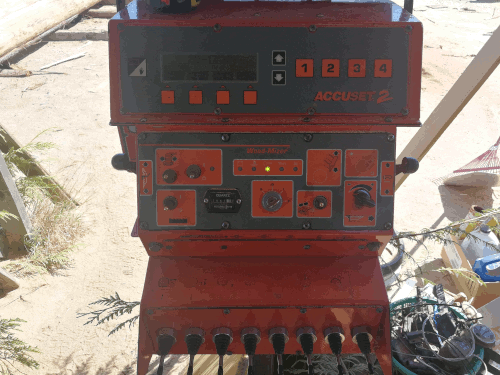
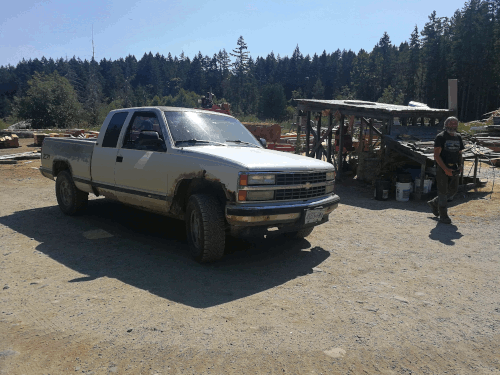
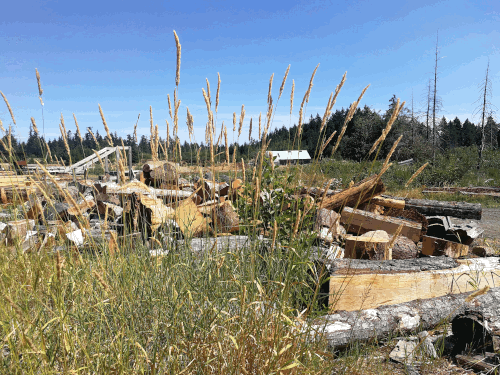
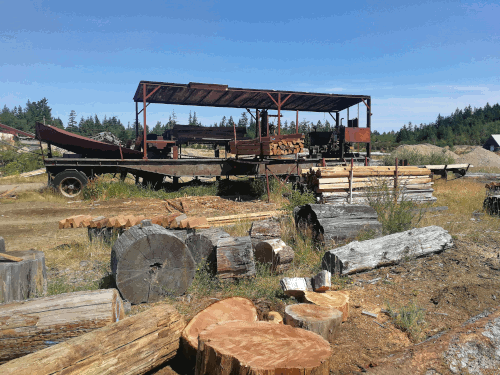
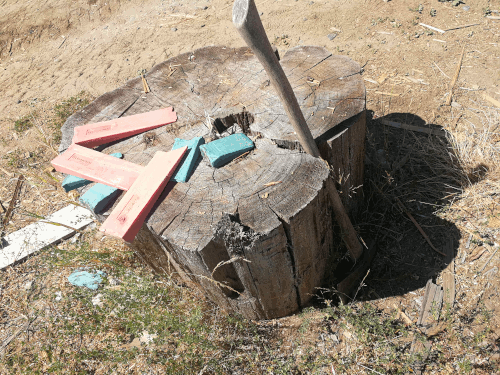
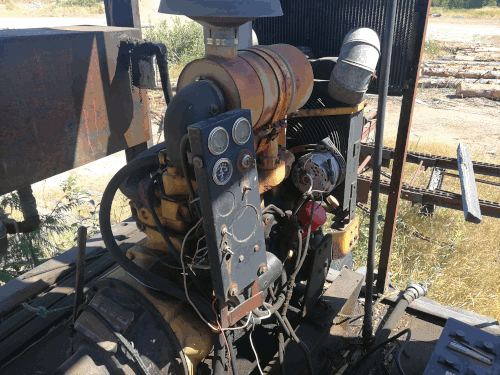
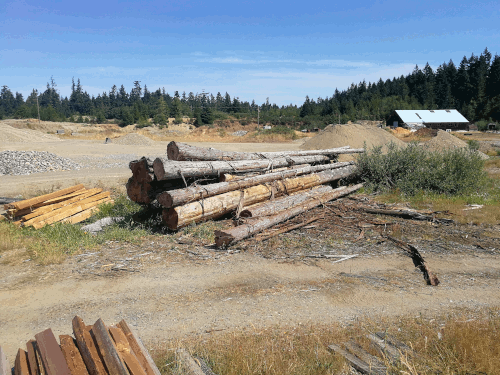
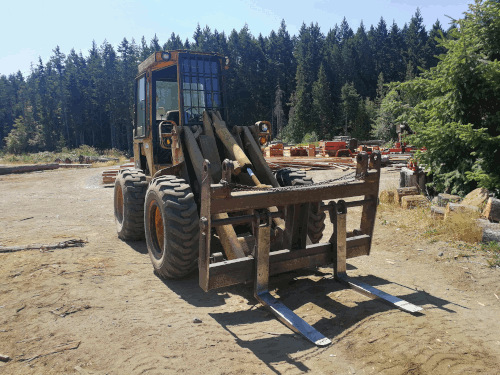
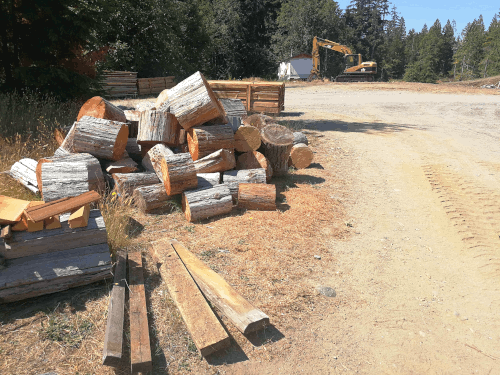
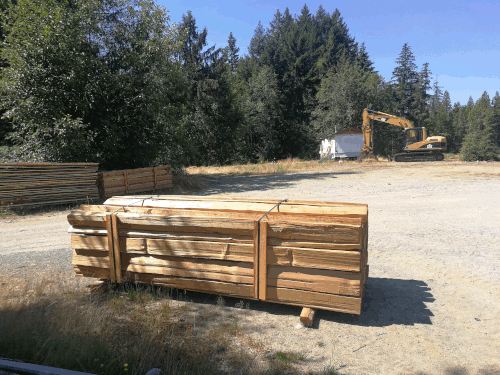


|
